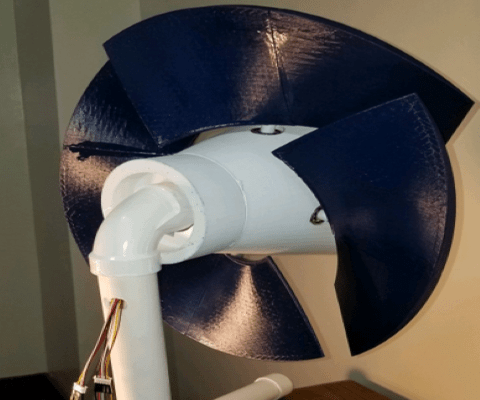Flowserve has enlisted Penn State in creating a mechanism that can adjust the blade angles of their pump impellers.
Sponsor

Flowserve
Team Members
Joseph Walsh | Jordan Masia | Daniel Yednock | Matthew Chan | Caitlin Mulqueen | Jeremy Spicher | | | | | |
Project Poster
Click on any image to enlarge.
Project Summary
Overview
Flowserve has enlisted Penn State in creating a mechanism that can adjust the blade angles of their pump impellers. Changing the blade angles influences the pump performance, fluid velocity, and efficiency. We are tasked to provide a physical prototype, 3D CAD models, FEA analysis, and the control mechanism code to our sponsor. The engineering design process was critical in creating a proof-of-concept mechanism to help Flowserve expand versatility in their product line.
Objectives
The mechanism’s main objective is to adjust the impeller blade angle without disassembly of the pump. The angles of the blade must vary by three degrees in either direction from its original angle. The blade angle must be maintained against the pressure of the flow. The mechanism itself must also withstand the operational forces applied.
Approach
– We started our project with a researching phase to determine benefits of this project, evaluate any similar products, and determine important needs of our design
– Our designs were narrowed down using a concept screening matrix, and the best design was chosen from a concept scoring matrix
– We developed an alpha, beta, and final prototype in SolidWorks, incorporating feedback from our peers and Flowserve between each design phase.
– Once our design was being finalized, we built a prototype constructed primarily of 3D printed PLA plastic, and a few purchased gears and bearings.
– FEA was used to evaluate structural integrity of the design with different materials.
– Another part of the team programmed and Arduino to allow a user to turn a rotary encoder to turn a motor that would move the pump vanes.
– Finally, we combined the mechanical and electrical components to complete our final prototype.
– Blade angle markings were added to the prototype to verify our design performed as intended.
Outcomes
– The resulting proof-of-concept is capable of varying blade angles by three degrees in either direction, giving Flowserve a foundation for developing new variable angle impellers.
– The initial Arduino code developed is capable of manipulating the pump without requiring direct access to the pump casing, adding flexibility to Flowserve’s existing product lineup.
– Controls can be expanded to implement remote operation for hard to-access pumps and future smart sensor usage.
– The finite element analysis conducted provides Flowserve insight into the structural requirements of a full-scale product.




